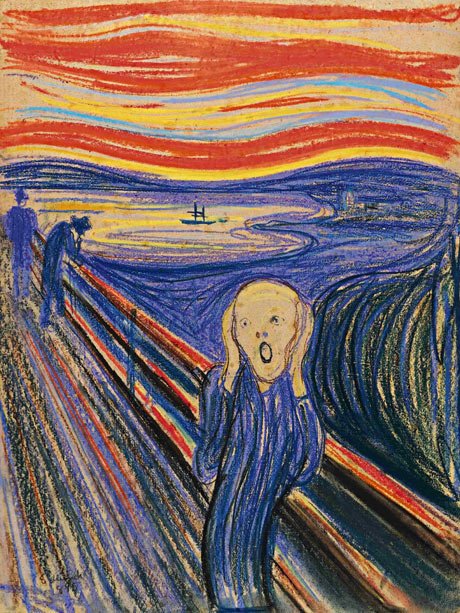
"The Scream?" the doorman asks. I nod. "Straight through and up the stairs to your left."
"No screaming," says another doorman, pointing to the infant strapped to my chest.
I check my bag and go through three security checkpoints before finally entering a dark room containing more security than punters and one £50m pastel glowing sinuously from the far wall.
I have a two-minute audience with Edvard Munch's The Scream, the third version he created of four (not counting his woodcuts, known as The Cry) and the only one in private hands. It is making its way to auction at Sotheby's in New York next month by way of a limited London showing. It is also the only one to actually leave Norway: the other three, all in Oslo museums, are not insurable to lend due to the potential for theft, which only adds to the appeal. (One of them was simply lifted off the wall and walked out, apparently.)
Originally created for Norwegian shipbuilder Thomas Olsen, this version is pastel on board and features a prose poem by Munch painted on the original frame. It also has a variation: of the two figures on the bridge, which are either approaching or retreating from the central figure, one is leaning against the bridge's handrail, forehead in hand. It changes the reading of the piece, which Munch himself never revealed.
Behind me the experts are educating. One is pontificating on the "flowing lines", which I can't help but think is the kickoff to a pickup, and another -- a man in his late 50s with longish grey hair, square frames and a tendency to pat his rear end, as all the men here seem to do -- explains the origin of this painting to a dim but excruciatingly well-dressed American woman, who apparently couldn't be arsed to read the exact same text outside the gallery, despite the fact it was on a display 30 feet high. If this broad has £50m to drop on a painting there in no justice.
Nobody says how the pastels really just look like Crayola, that the piece is much bloodier than any of the reproductions suggest, or that the face, which is mostly unworked board peaking through, is ghostly and washed out in comparison to the rest of the saturated colouring and therefore that much more haunting and sad. They also don't comment on how small it is. The smaller version of the inflatable scream my other bought me during my mid-twenties breakdown is surprisingly comparable in size.
What they also don't say is how much more impressive it is in person, or more pointedly, how disappointing other masterworks are up close: the Mona Lisa is impossible to get to as it hides behind Plexiglas and flash-popping tourists, who not only seem oblivious to the fact that each flash is physically damaging the paint but also are taking pictures of a painting they could easily buy reproductions of in the Louvre's many gift shops. At MoMa they click-click flash-flashed around van Gogh's Starry Night as though proud of themselves for recognising at least one masterwork, as if that damn painting isn't a screen saver for dorm room walls. The ubiquitousness of Leonado da Vinci or Vincent van Gogh -- and their merchandising -- makes their work underwhelming up close, but the opposite is true of Munch. Inflatable Screams, key chains, postcards, prints, finger puppets, and Simpsons parodies aside (I am guilty of buying all of these), the violence and horror in his work -- which prompted a ban by the Nazis, if you can stomach that particular irony -- make his pieces that much more immediate and striking.
Hopefully a museum not in Norway will buy The Scream next month and not some rich bastard who will squirrel it away on a yacht or some such shit. Not that there's anything wrong with visiting Oslo, of course. But.
And if anyone has a copy of The Mystery of The Scream board game, please let me know. I'm dying to play it.
0 sugar rushes:
Post a Comment